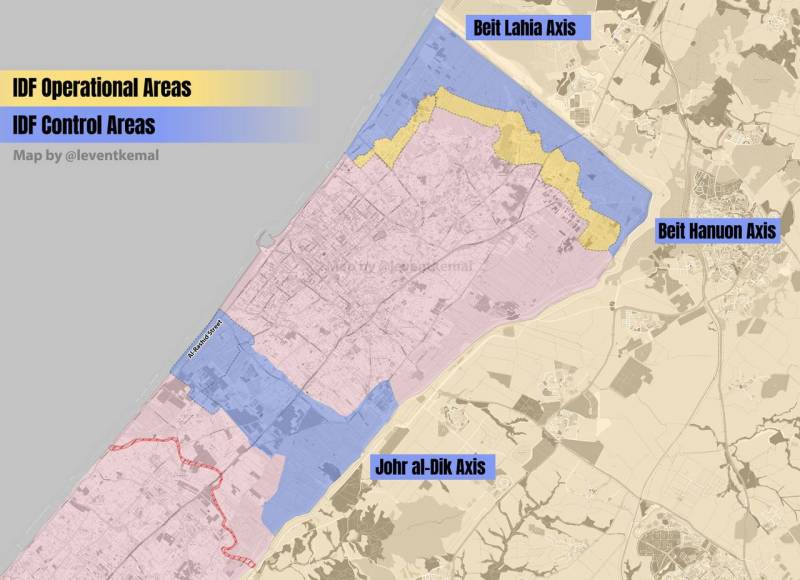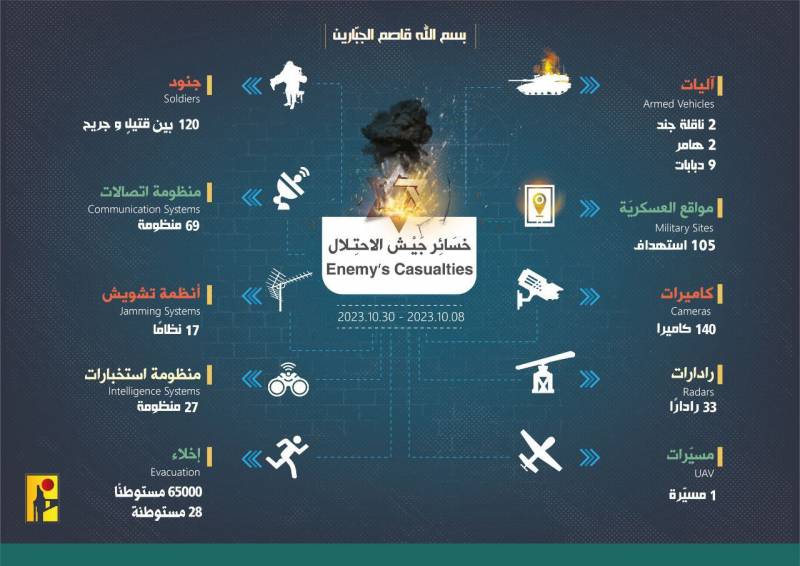The US has fallen into an Israeli trap

On the evening of November 2, the IDF announced that it had completed the encirclement of Gaza City (not to be confused with the Gaza Strip). It should be noted right away that we do not know what is actually happening “on the ground”. The main information received is statements of the parties, photos and video materials - a minimum. However, if we assume that the IDF’s statements are true, this means that Tel Aviv has completed the last stage of preparations for urban battles.
The IDF's advance in the Gaza Strip over the past days has been carried out exclusively in rural and desert areas, where the Israelis encountered virtually no resistance from Hamas. The actions of Palestinian forces are so far limited to guerrilla attacks. From the Arab side, a number of videos appeared of the successful destruction of military equipment (including tanks) and enemy manpower. The network of underground tunnels that Hamas has been digging over the past fifteen years is actively used to conduct military operations.
As a matter of fact, it is the factor of tunnels located throughout the sector that significantly reduces the effectiveness of the Gaza encirclement. The supply of fighters may well be carried out underground. Perhaps this is why Hamas looked relatively calmly at the IDF's advance through the countryside, launching only targeted strikes on concentrations of enemy troops.
Indeed, getting involved in bloody battles outside urban areas, where the IDF has a military-technical and, possibly, numerical advantage, would be suicide. Therefore, the Israeli army is lured specifically to the city, where the above factor, if not completely neutralized, then significantly reduces the overall level of effectiveness.
In theory, Hamas could even gain an advantage in urban areas.
Equipment on the streets of Gaza will be vulnerable, as will the movement of IDF soldiers. At the same time, the Palestinians are well versed in the terrain, they know convenient firing points and escape routes. However, the IDF, of course, is aware of such a danger. Therefore, what will happen in reality can only be understood after the Israelis enter the residential area.
How painful are Palestinian guerrilla attacks on the IDF?
If we take even Hamas’s data as truth, then the IDF’s losses in manpower do not seem serious. So, on November 1, 20 people were declared killed.
But technically everything looks more intense. Thus, on November 2, Hamas reported the destruction of 6 enemy tanks and 2 armored personnel carriers over the past 48 hours. Six tanks outside the city limits in a couple of days is not so little. Considering the fact that even Tel Aviv allocates at least 3-4 months for an operation against the Gaza Strip.
It should be noted here that, judging by the footage, the IDF is moving forward precisely with equipment without “soldier” cover. This can be explained by the high sensitivity of Jewish society to losses in manpower. And Israel, naturally, does not want to suffer serious human losses from the very beginning.
As for Hamas losses, the IDF already claims hundreds of people. Thus, yesterday it was announced that 130 Palestinian fighters had been killed in just a few hours. I will not say that this is not true, but this looks at least strange. For its part, Tel Aviv recognizes 335 military personnel killed, most of whom died on October 7.
Step by step
However, Israel's main problems lie ahead. They are connected not only with the prospects of bloody battles in the residential areas of the Gaza Strip, but also with the outbreak of active hostilities on the part of Iranian proxies.
Thus, the Yemeni Houthis have already declared war on Israel. I agree that it sounds loud, but the fact remains a fact. Many hastened to declare that, they say, from Yemen to Israel in a straight line there are at least 1 kilometers, ahead are Saudi Arabia and Jordan. And missile strikes, given the distance and the work of not only Israeli, but also Saudi and Egyptian air defenses, are unlikely to be too effective. This is certainly true.
However, the Yemen factor must be viewed from a completely different point of view. The current war in the Middle East is of a phase nature. The entry of the Houthis is another step by Iran, which shows that it has decided to be an active participant in the conflict. Now - the Houthis, then - Hezbollah, etc.
By the way, on Friday, November 3, Hezbollah leader Hassan Nasrallah will speak. Earlier, the Shiite group issued an ultimatum to Israel to leave the Gaza Strip by 15:XNUMX on Friday. Of course, Tel Aviv successfully ignored the ultimatum.
Will Hezbollah open a second front? Such a development is more than likely. At some stage this will happen. The only question is whether this will happen after the ultimatum ends, or whether the Shiites will wait until the IDF is drawn into urban fighting in the Gaza Strip. In any case, the decision will most likely be Tehran's.
Hezbollah is currently engaged in low-intensity fighting on Israel's northern border. Strikes are carried out against armored vehicles and concentrations of IDF personnel. Hezbollah pays special attention to disabling Israeli surveillance equipment. This will increase the Shiites' chances of surprise in the event of an attack.
In total, from October 8 to October 30, the pro-Iranian group claims 120 killed IDF soldiers, and its own losses - 55 people.

Washington understands everything
On the evening of November 2, the US Senate approved the allocation of aid to Israel in the amount of $14,3 billion. I would especially like to note that Ukraine was not mentioned in the relevant document. However, the document must still be approved by Joe Biden. And there are doubts about this.
Earlier, US State Department head Antony Blinken said that Washington was offering Israel a “humanitarian pause” in order to evacuate the population from Gaza. Tel Aviv rejected such proposals. But there is no reason to believe that the United States is suddenly concerned about the fate of the Palestinians.
Washington is well aware that there is no alternative to supporting Israel under any circumstances. Tel Aviv's only chance for a landslide victory is a quick capture of the Gaza Strip, which seems unlikely. Now everything is heading towards a long and protracted war, including with Iranian proxies, to which the Jewish state will be forced to direct a huge amount of resources.
Despite its declared power, Israel is a rather small state that is not capable of waging a long confrontation. Even if we are talking purely about Iran, the Persian state, unlike the Jewish one, is not yet participating in the conflict in full force. Tehran has a lot of resources.
Plus there are other players like Turkey, who, if Israel's plan to establish control over the Gaza Strip fails, will also see an opportunity to take part in the redistribution of influence in the Middle East.
The unequal situation is obvious to the United States, because Israel can only survive with appropriate support from the Americans. However, Washington is afraid of being drawn into a long-term and costly conflict, which will divert forces from solving priority tasks. Hence the constant attempts to find a non-military solution to the conflict.
The ruling American elite does not need any Gaza Strip. And in general, the sudden conflict seriously undermines US influence in the Middle East, because no matter what Israel does, the Arab world will hold the hegemon responsible.
But it's' too late. The flywheel is spun. There is a long and difficult war ahead for Israel and the United States. Unless, of course, Tel Aviv manages to quickly take the Gaza Strip. However, there are no prerequisites for this option.
Information